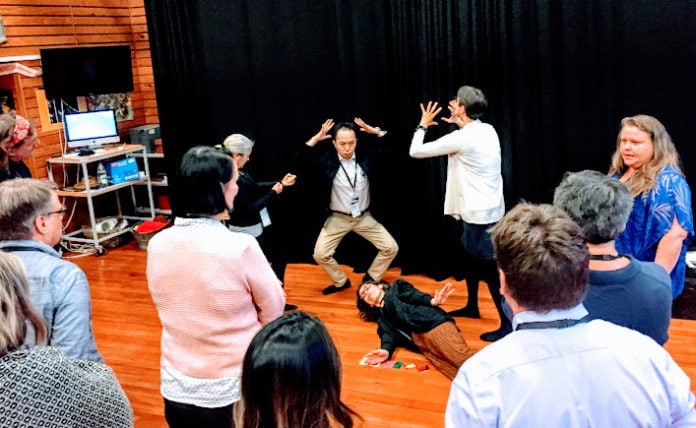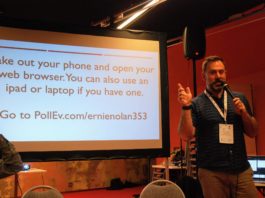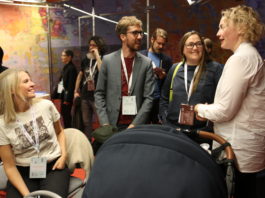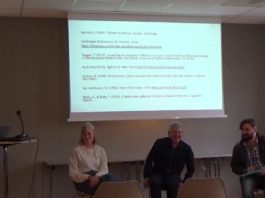Delegates at the 9th International Drama in Education Research Institute were treated to an abundance of exciting and engaging practical workshops during the 7-day event. To give you a flavour of what was on offer, the Dialogue team have put together a series of toolkits that include the workshop abstracts, biographies of the workshop leaders, and featured activities. It’s important to note that these activities are by no means comprehensive of the overall workshops but merely represent a small portion of the activities being introduced to participants.
Finding Our Compass: Applied Theatre as Reflective Practice
Facilitated by Warren Linds (Canada) and Elinor Vettraino (Scotland)
 “We define reflective practice as developed capacities to reflect on actions, behaviours and attitudes that impact on your own practice, or on the way others engage in their practice, so as to be part of a process of continuous learning. Our individual research explored ethical dilemmas with graduate students in process consultation through The Rainbow of Desire and doctoral research into a dramatherapeutic storytelling approach to build embodied reflexivity with educational practitioners. This workshop explores the concept of distance through the self-awareness of drama/theatre practitioners as arts based researchers and our capacity to ‘reflex’ in/on/with challenging actions, in the moment, with others. Exploring reflexivity through a dramaturgical lens, and drawing on the symbolism of the kai ariki, we invite researcher/ practitioners to hold up the mirror to their practice and explore, through critical incidents the challenges they have faced through story and theatre to create their own call to action.”
“We define reflective practice as developed capacities to reflect on actions, behaviours and attitudes that impact on your own practice, or on the way others engage in their practice, so as to be part of a process of continuous learning. Our individual research explored ethical dilemmas with graduate students in process consultation through The Rainbow of Desire and doctoral research into a dramatherapeutic storytelling approach to build embodied reflexivity with educational practitioners. This workshop explores the concept of distance through the self-awareness of drama/theatre practitioners as arts based researchers and our capacity to ‘reflex’ in/on/with challenging actions, in the moment, with others. Exploring reflexivity through a dramaturgical lens, and drawing on the symbolism of the kai ariki, we invite researcher/ practitioners to hold up the mirror to their practice and explore, through critical incidents the challenges they have faced through story and theatre to create their own call to action.”
Dr. Warren Linds is Associate Professor of Applied Human Sciences, Concordia University, Montreal, Canada and uses applied theatre to explore social justice issues and as a method of reflection into the ethics of professional practice. He has conducted arts-based research into wellbeing with Indigenous youth in partnership with a Canadian Indigenous health organization. He is co-editor of Playing in a House of Mirrors: Applied Theatre as Reflective Practice (Sense Publishers, 2015), Emancipatory practices: Adult/youth engagement for social and environmental justice (Sense Publishers, 2010).
Elinor Vettraino leads the business and enterprise area at Bishop Grosseteste University in Lincoln, England. She has worked extensively with applied theatre processes, recently using storytelling as a method of reflective practice processing with education professionals and leaders. Her most recent book Playing in a House of Mirrors: Applied Theatre as Reflective Practice co-edited with Dr Warren Linds, was stimulated by her doctoral research into the 6-Part-Story Method.
Featured Activity:
- The 6-Part-Story method is used as the workshop framework
- To start, the Facilitators ask the participants to think of a time in their research and/or practice where they experienced a dilemma and to keep that in the back of their mind throughout the workshop
- Participants are then paired up and given five cards, each with pictographs that represent the following:
- .. card 1: The character
- .. card 2: The task the character has to carry-out
- .. card 3: A helpful force
- .. card 4: A hindering force
- .. card 5: How the character attempts to overcome obstacles and achieve the task
- Each participant is asked to think of a fictitious, fantastical story that uses the pictographs as inspiration
- Participants share these stories with a partner and together they are instructed to create two still images that represent each story
- These still images are then shared with the larger group without follow-up comments or analysis
- To follow, each pair chooses another pair to work with whose stories they feel ring similar to their own stories
- In this group of four, participants share their individual narratives with one another, and the group collectively decides on which story to focus on (they are also given the option of combining narratives)
 The same steps from earlier are followed: each group is instructed to create a collective still image to illustrate their story
The same steps from earlier are followed: each group is instructed to create a collective still image to illustrate their story- Once this still image has been created and shared with the larger group, the Facilitators provide a sixth pictographic card that is to represent the following:
- .. card 6: The conclusion of this element of the story – though not necessarily the end of the story
- As a group, participants create a second still image to embody the ending of their collective story (as depicted by the sixth card)
 Both still images are then shared with the larger group who offer feedback about what they see and what this may represent (but no story is not clarified or revealed with the larger group)
Both still images are then shared with the larger group who offer feedback about what they see and what this may represent (but no story is not clarified or revealed with the larger group)- The Facilitators comment on how each narrative can and should be reflected upon after the workshop in terms of how it links back to the participants’ own life and work
- The Facilitators reference the initial dilemmas the participants had to think about at the start of the workshop and encourage them to probe whether or not their narratives may represent the storytelling process in some way
Using Dorothy Heathcote’s Circle of Progression
Facilitated by Tim Taylor (United Kingdom)
This workshop delves into the use of Dorothy Heathcote’s Circle of Progression when teaching students interdisciplinary subjects. Through the incorporation of Mantle of the Expert, Tim Taylor explores an alternative and effective way of engaging students in an inclusive and interactive classroom.
Tim Taylor is a teacher-trainer with over twenty years teaching experience. Since 1998 Tim has been researching and practising Mantle of the Expert, first in his own classroom and then in the classrooms of other teachers. He has led and participated in many professional development projects in schools across the UK and abroad. Including teaching in the USA, India, France, New Zealand, and Palestine and is a visiting lecturer at Newcastle University. He is the web manager for mantleoftheexpert.com. And has worked as consultant for the BBC and written many articles for papers and magazines, including the Guardian Teacher website. Tim is the author of ‘A Beginner’s Guide to Mantle of the Expert’ and a project tutor for the National Education Union Mantle of the Expert Programme. He tweets at @imagineinquiry
Featured Activity:
- The Facilitator introduces the Circle of Progression (also known as “a teacher’s compass”) by initially providing the participants with a printed copy of the Circle diagram
- The Facilitator depicts this structure as being fluid and flexible to the needs of the classroom and explains that it is typically implemented as follows:
- … Activity – Cycle 1 – Activity – Cycle 2 – Activity – Cycle 3 …
 The Facilitator introduces the classroom topic (in this case, Ancient Egypt) to the participants by displaying an image of a hieroglyph
The Facilitator introduces the classroom topic (in this case, Ancient Egypt) to the participants by displaying an image of a hieroglyph- As part of the first quadrant of the cycle, participants are asked to discuss in pairs what they notice in the image without making any descriptive/meaning-making comments
- .. This quadrant invites participants to open up and explore a topic without cost; no facilitation is required
- To transition into the second quadrant of the cycle, the Facilitator asks the participants to discuss what patterns they notice in the image, orienting them towards specific details but still without providing explanation
- .. This quadrant focuses on participants’ inquiry process but does not provide the ‘right’ answer; some facilitation is required
- Moving into the third quadrant of the cycle, the Facilitator explains the meaning behind the image (the story of Ancient Egypt) and the intentions behind the patterns/details that were pointed out by the participants previously
- .. This quadrant provides the exact answers for the participants where their role is to now listen to the facilitator
- In concluding with the fourth quadrant, the Facilitator poses to the group what they believe this image suggests about the Ancient Egyptian culture
- .. This quadrant focuses on participants’ reflections to the larger subject
- The Facilitator then makes use of the Cycle of Progression to lead a separate Mantle of the Expert activity wherein the participants take on the role of local archaeologists in Egypt
- The same format (moving through the various quadrants) is followed, probing the participants to think of questions in a more interactive manner







